German Inner Africa Research Expeditions
The German Inner Africa Research Expeditions (Deutsche Innerafrikanische Forschungs-Expeditions, DIAFE) were a series of 14 expeditions to Africa carried out between 1904 and 1955 by German scientists. The first 12 of these expeditions were led by the ethnologist Leo Frobenius and they are sometimes referred to as the Frobenius Expeditions.
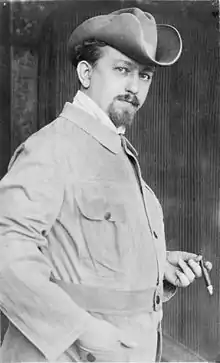
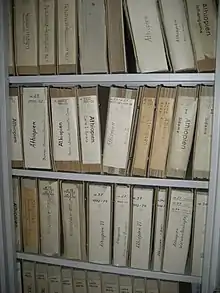
Overview
Leo Frobenius was a self-taught German ethnologist and archaeologist who specialised in African cultures. He published his first articles on Africa at the age of 21 (circa 1894).[1] Frobenius led twelve German Inner Africa Research Expeditions (Deutsche Innerafrikanische Forschungs-Expeditions, DIAFE) to Africa between 1904 and 1935.[2] He intended these to comprise a systematic analysis of African culture.[3] Frobenius published details of the expeditions in numerous books and journal articles and the majority of his original field notes, drawings and photographs have survived with many being preserved at the Frobenius Institute in Frankfurt.[4] Two further expeditions were organised after Frobenius' 1938 death by his student Adolf Ellegard Jensen.[2]
The scale of the expeditions has been described as epic and Frobenius' work is of considerable value for its documentary nature.[5] Frobenius has been described as the "pioneering German comparative ethnographer of Africa" and a "master of the general survey" and was in the development of anthropology in Germany.[6] He developed the theory of "culture morphology" - the idea of culture as a living organism and its development by diffusion from a limited number of "culture areas" (for example the ancient Greeks).[5] Frobenius theorised that many of the artefacts he found in his expeditions were of non-African origin. His subsequent conclusions about the development of African civilisations from pre-existing non-African cultures have proved controversial and are not supported by modern writers.[5] Frobenius has also been accused of using the expeditions to loot items of cultural value from Africa.[7]
First expedition
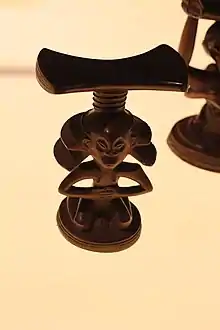
Frobenius provided the initial funding for this expedition himself.[8] It ran from 1904 to 1906 and explored the Kasai region of the Congo.[9] Frobenius himself later described it as an "almost foolhardy" enterprise in which he undertook with a Hamburg Museum to supply as many artefacts as possible for a low price.[10] Frobenius' wife Editha was in charge of organising the movements of the expedition and managing supplies of food, water and medicine.[11] The expedition also had a dedicated artist by the name of Lemme. The expedition returned to Germany in 1906 having secured 8,000 pieces for the museum.[10] Frobenius published Im Schatten des Kongostaates (In the Shadow of the Congo State) in 1907 based on this expedition.[11]
Second expedition
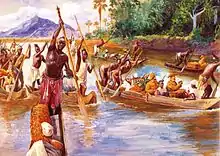
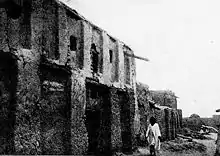
The second expedition was funded by the German Colonial Office and supported by the City of Leipzig.[12][13] It ran from 1907 to 1909 and primarily ran from Senegal through Niger and Liberia to Togo. Frobenius also visited Mali (including the ancient city of Timbuktu), Burkina Faso and the Ivory Coast.[9][8][11] During the expedition Frobenius collected stories from the inhabitants and published some of them, of an erotic nature, in a 1910 collection entitled Der Schwarze Dekameron (The Black Decameron).[11]
Third expedition
_Fig27_Fr%C3%BChling_1910%252C_im_Oued-Bassira.jpg.webp)
The third expedition was carried out in 1910 to Northwest Africa.[9] It visited Morocco, Algeria and Tunisia.[9] Frobenius collected stories from the Berbers and carried out a study of the Kabyle people.[8][11]
Fourth expedition
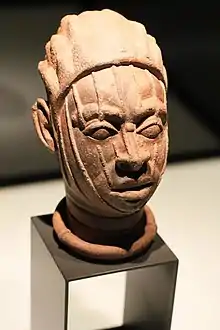
The fourth expedition visited Nigeria and Cameroon between 1910 and 1912.[9] Frobenius carried out archaeological excavations at the ancient Yoruba city of Ife in Nigeria and published his findings in twelve volumes between 1921 and 1928.[11][14][15] Frobenius theorised that the intricate bronze and terracotta sculptures he discovered at Ife were relics from the mythological city of Atlantis.[11] However, later research has shown them to be the work of 12th-15th century AD Yoruba craftsmen.[15]
Fifth expedition
Frobenius led the 1912 fifth expedition to Kordofan in Anglo-Egyptian Sudan with the objective of locating the mines of Hophrat-en-Nahas in the Kingdom of Kush.[9][11][16] The expedition travelled through Egypt via Suez and Port Sudan.[16] Frobenius also visited Khartoum and El Obeid in Sudan.[16] Upon returning to Germany he found his fame had earned him an audience with Wilhelm II (the German emperor) who agreed to sponsor his future expeditions.[11]
Sixth expedition
The sixth Frobenius expedition explored Algeria between 1912 and 1914.[9] The expedition documented rock art from the Saharan region and in 1913 excavated ancient tombs on the Moroccan border.[11][17]
Seventh expedition
The seventh expedition was to Eritrea in 1915.[18] It served as a front for a German military espionage mission to Ethiopia, and was intended to persuade Emperor Lij Iyasu to support the Central Powers in the First World War and provide assistance to a Mahdist uprising in the Sudan.[19] This could have threatened British and Italian colonies in Eastern Africa and possibly the vital supply route of the Suez Canal.[1] The party crossed the Red Sea in a sambuk but were discovered by the Italian authorities soon after their arrival in Eritrea and had no opportunity to enter Ethiopia. Frobenius and the expedition were eventually granted safe passage to Italy.[18]
Eighth expedition
The eighth expedition travelled to the Nubian Desert in Sudan in 1926.[9] Part of its work was to document rock art.[17]
Ninth expedition
The ninth expedition ran between August 1928 and March 1930 in Southern Africa.[9] It visited parts of modern-day South Africa, Zimbabwe, Botswana, Lesotho, Mozambique, Namibia and Zambia.[7] It recorded a large quantity of indigenous rock art, which helped Frobenius to build one of the most important collections of such work, some of which was sold to South African museums.[20][21] It also investigated ancient ore mines and provided samples for some of the first metallographic and chemical analysis of southern African indigenous metals.[22]
Tenth expedition
The tenth Frobenius expedition was carried out in 1932 to Fezzan in Italian Libya.[9] It started from Tripoli and part of the route was carried out by motor car procured through the German consul. The expedition returned to Rome by mid September.[23]
Eleventh expedition
.png.webp)
The eleventh expedition was carried out in 1933 to the Libyan Desert.[9]
Twelfth expedition
The Twelfth German Inner Africa Research Expedition was carried out between 1934 and 1935 in the Emirate of Transjordan and Ethiopia.[9] The expedition was led by Frobenius, though he did not accompany it - the leader of the field group was Jensen.[24] This would be the last of the Frobenius Expeditions to Africa; though he would lead the "Frobenius Expedition I" to New Guinea in 1937-8 and the "Frobenius Expedition II" to Australia in 1938. He died in August 1938.[25]
Jensen published the findings from the twelfth expedition as a book in 1936. He later took over the directorship of the Frobenius Institute.[24]
Thirteenth expedition
Jensen resumed the German Inner Africa Research Expeditions after the Second World War.[9] Jensen struggled to raise money in war-devastated Frankfurt but managed to secure funding for an expedition to Ethiopia.[26] Jensen led the expedition which took place between 1950 and 1952.[9][26] Jensen's party included doctors Eike Haberland and Willy Schulz-Weidner; Haberland later also became a director of the Frobenius Institute.[26]
Fourteenth expedition
The final German Inner Africa Research Expedition was led by Jensen to Ethiopia between 1954 and 1955.[9]
The institute undertook further expeditions to Ethiopia, though these were under a separate programme. The expeditions were halted in 1974 among political turmoil following the socialist takeover of Ethiopia. The institute's Ethiopian Studies department ceased to exist until re-established in 2010.[27]
References
- Schmidt, Wolbert; Thubauville, Sophia (2015). Cultural Research in Northeast Africa: German Histories and Stories. Frankfurt: Frobenius-Institut. p. 173.
- Westphal-Hellbusch, Sigrid (October 1959). "The Present Situation of Ethnological Research in Germany". American Anthropologist. 61 (5): 850. doi:10.1525/aa.1959.61.5.02a00110. ISSN 0002-7294.
- Westphal-Hellbusch, Sigrid (October 1959). "The Present Situation of Ethnological Research in Germany". American Anthropologist. 61 (5): 860. doi:10.1525/aa.1959.61.5.02a00110. ISSN 0002-7294.
- Schmidt-Brücken, Daniel; Schuster, Susanne; Wienberg, Marina (2016). Aspects of (Post)Colonial Linguistics: Current Perspectives and New Approaches. Walter de Gruyter GmbH & Co KG. p. 348. ISBN 9783110434026. Retrieved 30 January 2019.
- Wintjes, Justine (November 2013). "The Frobenius expedition to Natal and the Cinyati archive". Southern African Humanities: 167. Retrieved 6 July 2019.
- Wintjes, Justine (November 2013). "The Frobenius expedition to Natal and the Cinyati archive". Southern African Humanities: 168. Retrieved 6 July 2019.
- Wintjes, Justine (November 2013). "The Frobenius expedition to Natal and the Cinyati archive". Southern African Humanities: 170. Retrieved 6 July 2019.
- University of Melbourne (1955). "Article". Meanjin Quarterly. 14: 501.
- "Expeditions - Frobenius-Institut Frankfurt am Main". www.frobenius-institut.de. Frobenius Institute. Retrieved 28 February 2017.
- Occasional publication. African and Afro-American Studies and Research Center, University of Texas at Austin. 1974.
- Magill, Frank M. (ed) (13 May 2011). The 20th Century A-GI: Dictionary of World Biography, Volume 7. Abingdon, Oxfordshire: Routledge. p. 1243. ISBN 978-1-57958-046-9. Retrieved 3 October 2016.CS1 maint: extra text: authors list (link)
- Fuhrmann, Wolfgang (30 May 2015). Imperial Projections: Screening the German Colonies. Berghahn Books. p. 160. ISBN 9781782386988. Retrieved 3 October 2016.
- Anthropos. Zaunrith'sche Buch-, Kunst- und Steindruckerei. 1996. p. 484.
- "Collection online". British Museum. Retrieved 7 October 2016.
- Busari, Stephanie (21 June 2010). "The African sculptures mistaken for remains of Atlantis - CNN.com". CNN. Retrieved 30 January 2019.
- Calasso, Roberto (1994). The Ruin of Kasch. Cambridge, Mass: Harvard University Press. p. 125. ISBN 9780674780262.
- "The Frobenius expedition to Natal and the Cinyati archive". Southern African Humanities. 25: 169. November 2013. Retrieved 15 July 2019.
- Da Riva, Rocío; Biocca, Dario (5 August 2016). "Leo Frobenius' Secret Mission in Arabia and Eritrea (1914–1915)". Arabian Humanities. Revue internationale d'archéologie et de sciences sociales sur la péninsule Arabique/International Journal of Archaeology and Social Sciences in the Arabian Peninsula (in French) (6). doi:10.4000/cy.3099. ISSN 1248-0568. Retrieved 25 February 2019.
- Schmidt, Wolbert; Thubauville, Sophia (2015). Cultural Research in Northeast Africa: German Histories and Stories. Frankfurt: Frobenius-Institut. p. 174.
- Wintjes, Justine (November 2013). "The Frobenius expedition to Natal and the Cinyati archive". Southern African Humanities: 169. Retrieved 6 July 2019.
- "Pre-colonial Archaeology". Iziko Museums of South Africa. 3 September 2015. Archived from the original on 3 September 2015. Retrieved 30 August 2019.
- Miller, Duncan (1992). "Pioneering Metallographic Analyses of Indigenous Metal Artefacts from Southern Africa: Material Collected by the Frobenius Expedition in 1929/1930". The South African Archaeological Bulletin. 47 (156): 108–115. doi:10.2307/3889206. ISSN 0038-1969. JSTOR 3889206.
- Forschungen und Fortschritte (in German). Akademie-Verlag. 1932. p. 413. Retrieved 30 January 2019.
- Schmidt, Wolbert; Thubauville, Sophia (2015). Cultural Research in Northeast Africa: German Histories and Stories. Frankfurt: Frobenius-Institut. p. 179.
- Haller, Dieter (2012). Die Suche nach dem Fremden: Geschichte der Ethnologie in der Bundesrepublik 1945-1990 (in German). Campus Verlag. p. 156. ISBN 9783593396002. Retrieved 1 July 2019.
- Schmidt, Wolbert; Thubauville, Sophia (2015). Cultural Research in Northeast Africa: German Histories and Stories. Frankfurt: Frobenius-Institut. p. 180.
- Schmidt, Wolbert; Thubauville, Sophia (2015). Cultural Research in Northeast Africa: German Histories and Stories. Frankfurt: Frobenius-Institut. p. 181.